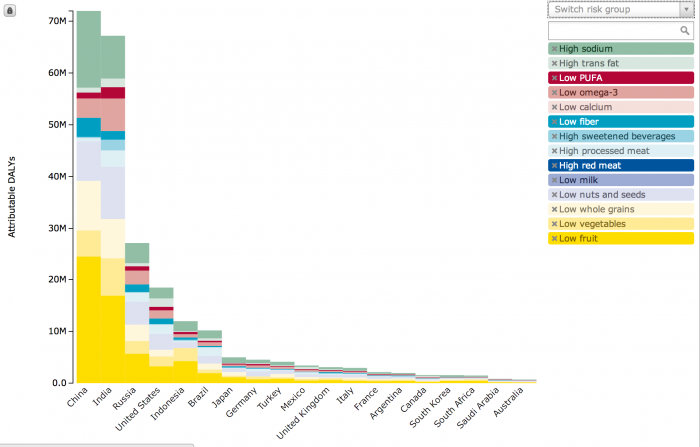
You’ve probably heard that China has one of the world’s fastest growing economies.
GDP growth has been hovering around 10% every year for decades since they switched from a centrally planned economy to a market based economy in 1978. In that same time period the world’s most populous country has seen drastic improvements in everything from infant mortality rate and life expectancy, to school enrollment and income levels.
But while economic and some social indicators look healthy, all is not well in China.
One of the most critical issues they face right now is heart disease, something that afflicts 230 million Chinese.
“We’re seeing the spinoff effects of an aging population and a more affluent population who are running into some health problems that the Western World has seen,” said William Heisel, Director of Communications at the Institute for Health Metrics and Evaluation (IHME).
IHME is a global health research institute at the University of Washington which aims to provide a comprehensive source of worldwide health data to aid countries in strategic decision-making to keep their people living longer, healthier lives.
In 2010 IHME headed up a collaboration with medical researchers from around the world and released the Global Burden of Disease study, which measured the impact of hundreds of health risks and health risk factors in over 20 regions around the world.
The Global Burden of Disease (GBD) measures the impact of diseases using a factor called disability-adjusted-life-year (DALY).
DALY is a unique metric that combines years of life lost due to early death (YLL) and years lived with disability (YLD), according to the World Health Organization. This measurement was introduced to the medical community because it is more informative and easier to break down than a traditional death count.

The study, which was published by The Lancet, found that 160 million of the 240 million DALYs in China are due to heart disease. The top three preventable contributors to these 160 million DALYs were found to be diet, pollution, and tobacco use respectively. (High blood pressure is technically another major contributing factor, but it is in turn primarily caused by tobacco use and poor diet.)
Though it may seem obvious now, four years ago the general public had not fully grasped the significance that China’s CO2 emissions had increased from 2.2 metric tons per year in 1990 to 6.2 metric tons per year in 2010.
Both ambient pollution and household air pollution make up nearly 32 million of the 160 million DALYs connected to heart disease.
In the years since the release of the study, there have been large protests all over China against coal and fossil fuel use, two of the biggest factors of carbon emissions and air pollution.
The Chinese government has responded by greatly improving upon its Environmental Protection Law, recently adding amendments requiring businesses to be more transparent in their environmental information as well as giving environmental authorities more power.
Tobacco smoking accounts for 19 million of the 160 million DALYs due to heart disease in China.

China is the largest consumer of cigarettes in the world, about one in every three cigarettes smoked in the world is smoked in China and almost 4 million of the DALYs are due to second hand smoke alone.
Recently, the Chinese government has been taking steps towards banning tobacco use in the country.
“Even though it’s the government of China that basically runs the tobacco industry, just like it runs most industries there, they have decided that they are going to take measures to decrease smoking,” Heisel said
China recently banned smoking in schools and health offices, and they hope to ban all public indoor smoking by the end of 2014.
Air pollution and smoking are big health risks. But dietary risks blow them out of the water, with over 41 million of the 160 million DALYs coming due to heart disease.
Heisel said many Chinese people’s diets are missing basic food groups like fruits and vegetables, as well as nuts and seeds, and they are overabundant in things like sodium, sugar, and red meat (sounds a lot like the U.S.).
Some experts suggest that subsidizing fruits and vegetables, like many European countries have done, would make healthy foods more affordable and, in turn, would improve China’s diet. According to IHME’s findings, the largest dietary risk factor for heart disease in China is lack of fruit in one’s diet, contributing to nearly twice as many DALYs as high sodium.
There is no doubt that China’s contemporary health issues were mostly caused by their economic transition over the past 30 years. Before that, cigarette consumption was low, pollution was low, and diet was much better.

In fact, traditional Chinese diet is very healthy, says Senhao Liu, a student at University of Washington, who moved to the U.S. in 2011 from an urban area on the East Coast of China.
“Our ancestors had left us much value of living healthy since 5,000 years ago,” he said. “For example, we created a complete system of eating and medicine. Drinking tea is one of the healthy habits for Chinese people and I drink tea every day.”
Policy solutions to any of these problems would be very practical to implement if we were talking about a small European country or even other small to medium sized Asian countries.
But the reality is, China has more than 1.3 billion people, and its provinces are incredibly diverse ranging from very rich and urban to very poor and rural. Enacting policies at a national level is just not that effective — they need more targeted information.
This is where IHME’s new study comes in. For the past year they’ve been working with over 1,000 researchers from 106 different countries to collect data for a study that is solely focused on health in China.
IHME is heading up this study and is working directly with the Chinese Center for Disease Control (CDC) as well as Peking University, one of the top universities in Asia.
Their goal for this research is to use the strategies of their 2010 study that focused on the impacts of a multitude of health risks and risk-factors, but to bring those down to a local level.
“We’ve been working closely with these researchers to analyze disease patterns and provide information to the government… to help them set priorities and plan,” Heisel said. “It’s about what is literally happening on the ground in China, where they are seeing successes and where they are seeing problems. We’re seeing where they can learn from the patterns of their own population.”
Heisel said they hope to publish these findings later this year. The hope is that by localizing patterns of disease and focusing on each individual province’s needs, China will be able to develop more realistic solutions for its health issues.
The publication could have a lot of interesting repercussions: citizens taking action, non-government organizations taking action, policy changes, and legislation.
Once it is published, IHME will also have the opportunity to add to their already impressive, first-of-its-kind interactive data visualizations on their website. These charts and tables, which have been in place since 2010 but became much more sophisticated at the end of 2012, allow users to interact with tables containing countless global health data and to sort that data by different factors such as cause, risk, location, gender, and more.

Katherine Leach-Kemon, a policy translation specialist at IHME, explained that everyone from policy makers to an average citizen can use the studies and the interactive data charts to inform themselves and to inspire new policies and legislation.
Leach-Kemon told me an anecdote from Rwanda just after the 2010 study was released, in which the findings had a direct impact. Rwanda’s Minister of Health at the time saw the results and was struck by the number of children dying from exposure to indoor household air pollution.
She worked with the Minister of Energy and they had clean cook stoves installed into 1.5 million households across Rwanda.
“We’re not an advocacy organization, so we’re not trying to pursue a particular agenda in any way, other than to try to estimate the truth as best as possible,” Leach-Kemon said. “We’re just hoping to spur positive change in the world.”

